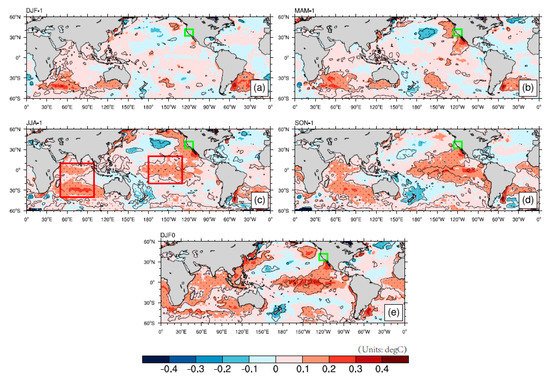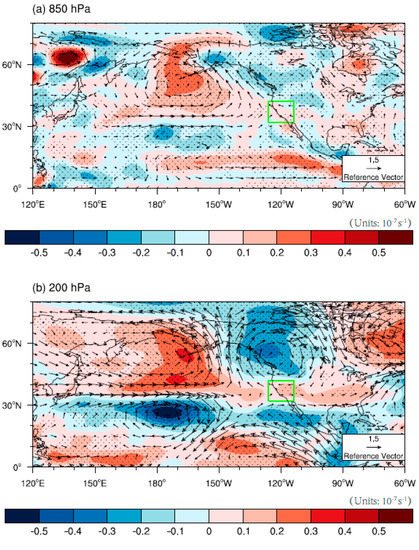Using observational data covering 1948–2020, the environmental factors controlling the winter precipitation in California were investigated. Empirical orthogonal function (EOF) analysis was applied to identify the dominant climate regimes contributing to the precipitation. The first EOF mode described a consistent change, with 70.1% variance contribution, and the second mode
exhibited a south–east dipole change, with 11.7% contribution. For EOF1, the relationship was positive between PC1(principal component) and SST (sea surface temperature) in the central Pacific Ocean, while it was negative with SST in the southeast Indian Ocean. The Pacific–North America mode, induced by the positive SST and precipitation in the central Pacific Ocean, leads to California
being occupied by southwesterlies, which would transport warm and wet flow from the ocean, beneficial for precipitation. As for the negative relationship, California is controlled by biotrophically high pressure, representing part of the Rossby wave train induced by the positive SST in the Indian ocean, which is unfavorable for the precipitation. For EOF2, California is controlled by positive
vorticity at the upper level, whereas at the lower level, there is positive vorticity to the south and negative vorticity to the north, the combination of which leads to the dipole mode change in the precipitation.
- California precipitation
- central Pacific Ocean
- Indian Ocean
- Rossby wave train
1. Introduction
2. Environmental Factors Affecting PC1 Changes
Since EOF1 and EOF2 described two different processes, the changes in PC1 and PC2 were analyzed separately. Figure 31 shows the evolution of SST patterns regressed to PC1 from the preceding winter to the subsequent winter. In both winters, we can see an El Niño-like pattern, which indicates that warm SST in the eastern Pacific Ocean corresponded to positive precipitation in California, consistent with previous studies [54][43]. It is worth noting that the positive relationship was continuous from the preceding winter to autumn. As the predictions of drought and flood are often needed one season in advance, and the signal in the preceding summer was most significant, the environmental factors were chosen in the preceding summer, as shown in Figure 31c. There was a positive relationship between SST in the central Pacific Ocean (red box; 20° S–20° N; 180–130° W) and California precipitation, as well as a negative relationship between SST in the southeast Indian Ocean (blue box; 40–10° S; 90–115° E) and California precipitation.
3. Environmental Factors Affecting PC2 Changes


4. Summary and Discussion
References
- Seager, R.; Hoerling, M.P.; Schubert, S.; Wang, H.; Lyon, B.; Kumar, A.; Nakamura, J.; Henderson, N. Causes of the 2011–2014 California Drought. J. Clim. 2015, 28, 6997–7024.
- Diffenbaugh, N.S.; Swain, D.L.; Touma, D. Anthropogenic warming has increased drought risk in California. Proc. Natl. Acad. Sci. USA 2015, 112, 3931–3936.
- US Census Bureau. State and County QuickFacts. 2014. Available online: Quickfacts.census.gov/qfd/states/06000.html (accessed on 20 March 2021).
- US Bureau of Economic Analysis. Bureau of Economic Analysis Interactive Data. 2014. Available online: www.bea.gov/ (accessed on 20 March 2021).
- US Department of Agriculture. CALIFORNIA Agricultural Statistics 2012 Crop Year. 2013. Available online: www.nass.usda.gov/Statistics_by_State/California/Publications/California_Ag_Statistics/Reports/2012cas-all.pdf (accessed on 20 March 2021).
- Zhu, Z.; Li, T. Amplified contiguous United States summer rainfall variability induced by East Asian monsoon interdecadal change. Clim. Dyn. 2017, 50, 1–14.
- Manuel, J. Drought in the Southeast: Lessons for Water Management. Environ. Health Perspect. 2008, 116, A168–A171.
- Gotvald, A.J.; Mccallum, B.E. Epic Flooding in Georgia, 2009. In U.S. Geological Survey Fact Sheet 2010-3107; U.S. Geological Survey: Reston, VA, USA, 2012; 2p.
- Griffin, D.; Anchukaitis, K.J. How unusual is the 2012–2014 California drought? Geophys. Res. Lett. 2014, 41, 9017–9023.
- Williams, A.P.; Seager, R.; Abatzoglou, J.T.; Cook, B.I.; Smerdon, J.E.; Cook, E.R. Contribution of anthropogenic warming to California drought during 2012–2014. Geophys. Res. Lett. 2015, 42, 6819–6828.
- Mao, Y.; Nijssen, B.; Lettenmaier, D.P. Is climate change implicated in the 2013–2014 California drought? A hydrologic perspective. Geophys. Res. Lett. 2015, 42, 2805–2813.
- Nitta, T. Convective activities in the tropical western Pacific and their impact on the northern hemisphere summer circulation. J. Meteorol. Soc. Jpn. 1987, 65, 373–390.
- Huang, R. The numerical simulation of the three-dimensional teleconnections in the summer circulation over the Northern Hemisphere. Adv. Atmos. Sci. 1985, 2, 81–92.
- Lau, K.M.; Weng, H. Recurrent Teleconnection Patterns Linking Summertime Precipitation Variability over East Asia and North America. J. Meteorol. Soc. Jpn. 2002, 80, 1309–1324.
- Lau, K.M. Dynamics of atmospheric teleconnections during the Northern Hemisphere summer. J. Clim. 1992, 5, 140–158.
- Ting, M.; Wang, H. Summertime, U.S. Precipitation Variability and Its Relation toPacific Sea Surface Temperature. J. Clim. 2010, 10, 1853–1873.
- Hui, W.; Ting, M.; Ming, J. Prediction of seasonal mean United States precipitation based on El Niño sea surface temperatures. Geophys. Res. Lett. 1999, 26, 1341–1344.
- Li, C.; Zhang, L. Summer monsoon activities in South China Sea and its impacts. Chinese. Sci. Atmos. Sin. 1999, 3, 23.
- Lau, K.M. Dynamical and Boundary Forcing Characteristics of Regional Components of the Asian Summer Monsoon. J. Clim. 2000, 13, 2461–2482.
- Wang, B.; Wu, R.; Lau, K.M. Interannual Variability of the Asian Summer Monsoon: Contrasts between the Indian and the Western North Pacific–East Asian Monsoons*. J. Clim. 2001, 14, 4073–4090.
- Trenberth, K.E.; Guillemot, C.J. Physical Processes Involved in the 1988 Drought and 1993 Floods in North America. J. Clim. 1996, 9, 1288–1298.
- Mo, K.C.; Paegle, J.N.; Higgins, R.W. Atmospheric Processes Associated with Summer Floods and Droughts in the Central United States. J. Clim. 1997, 10, 3028–3046.
- Livezey, R.E.; Smith, T.M. Covariability of Aspects of North American Climate with Global Sea Surface Temperatures on Interannual to Interdecadal Timescales. J. Clim. 1999, 12, 289–302.
- Mo, K.C. Intraseasonal Modulation of Summer Precipitation over North America. Mon. Weather Rev. 2000, 128, 1490–1505.
- Higgins, R.W.; Leetmaa, A.; Xue, Y.; Barnston, A. Dominant factors influencing the seasonal predictability of United States precipitation and surface air temperature. J. Clim. 2000, 13, 3994–4017.
- Ropelewski, C.F.; Halpert, M.S. North American Precipitation and Temperature Patterns Associated with the El Nio/Southern Oscillation (ENSO). Mon. Weather Rev. 1985, 114, 12.
- Palmer, T.N.; Brankovi, C. The 1988 US drought linked to anomalous sea surface temperature. Nature 1989, 338, 54–57.
- Mo, K.C.; Schemm, J.E. Relationships between ENSO and drought over the southeastern United States. Geophys. Res. Lett. 2008, 35, 212–222.
- Li, L.; Li, W.; Kushnir, Y. Variation of the North Atlantic subtropical high western ridge and its implication to Southeastern US summer precipitation. Clim. Dyn. 2012, 39, 1401–1412.
- Dai, A. The influence of the inter-decadal Pacific oscillation on US precipitation during 1923–2010. Clim. Dyn. 2013, 41, 633–646.
- Enfield, D.B. Relationships of inter-american rainfall to tropical Atlantic and Pacific SST variability. Geophys. Res. Lett. 1996, 23, 3305–3308.
- Wang, H.; Fu, R.; Kumar, A.; Li, W. Intensification of Summer Rainfall Variability in the Southeastern United States during Recent Decades. J. Hydrometeorol. 2010, 11, 1007–1018.
- Hu, Q.; Feng, S.; Oglesby, R.J. Variations in North American Summer Precipitation Driven by the Atlantic Multidecadal Oscillation. J. Clim. 2010, 1, 8.
- Curtis, S. The Atlantic multidecadal oscillation and extreme daily precipitation over the US and Mexico during the hurricane season. Clim. Dyn. 2008, 30, 343–351.
- McCabe, G.J.; Palecki, M.A.; Betancourt, J.L. Pacific and Atlantic Ocean influences on multidecadal drought frequency in the United States. Proc. Natl. Acad. Sci. USA 2004, 101, 4136–4141.
- Horel, J.D.; Wallace, J.M. Planetary-Scale Atmospheric Phenomena Associated with the Southern Oscillation. Mon. Weather Rev. 1981, 109, 813–829.
- Leathers, D.J.; Yarnal, B.; Palecki, M.A. The Pacific/North American Teleconnection Pattern and United States Climate. Part I: Regional Temperature and Precipitation Associations. J. Clim. 1991, 4, 517–528.
- Trenberth, K.E.; Branstator, G.W.; Karoly, D.; Kumar, A.; Lau, N.C.; Ropelewski, C. Progress during TOGA in understanding and modeling global teleconnections associated with tropical sea surface temperatures. J. Geophys. Res. Ocean. 1998, 103, 14291–14324.
- Coleman, J.S.M.; Rogers, J.C. Ohio River Valley Winter Moisture Conditions Associated with the Pacific–North American Teleconnection Pattern. J. Clim. 2003, 16, 969–981.
- Ge, Y.; Gong, G.; Frei, A. Physical Mechanisms Linking the Winter Pacific–North American Teleconnection Pattern to Spring North American Snow Depth. J. Clim. 2009, 22, 5135–5148.
- Xie, P.; Chen, M.; Yang, S.; Yatagai, A.; Hayasaka, T.; Fukushima, Y.; Liu, C. A Gauge-Based Analysis of Daily Precipitation over East Asia. J. Hydrometeorol. 2007, 8, 607–626.
- Chen, M.; Xie, P.; Janowiak, J.E.; Arkin, P. Global Land Precipitation: A 50-yr Monthly Analysis Based on Gauge Observations. J. Hydrometeorol. 2002, 3, 249–266.
- Barnston, A.G.; Livezey, R.E. Classification, Seasonality and Persistence of Low-Frequency Atmospheric Circulation Patterns. Mon. Weather Rev. 1987, 115, 1083–1126.
- Yang, H.; Lohmann, G.; Lu, J.; Gowan, E.J.; Shi, X.; Liu, J.; Wang, Q. Tropical Expansion Driven by Poleward Advancing Midlatitude Meridional Temperature Gradients. J. Geophys. Res. Atmos. 2020, 125, e2020JD033158.
